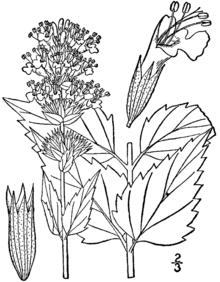EBP/Cooperative/Agastache foeniculum
< EBP < Cooperative
Agastache foeniculum
- Common names: Hyssop, Giant hyssop, Blue giant hyssop, Anise hyssop, Lavender hyssop,
- Names used by indigenous peoples: weza`wûnûckwûk` (Anishinabe)
- Wikipedia: Agastache
- Wikispecies: Agastache foeniculum
Medicinal uses
Leaves
- For burns: Used by the Anishinabe in a poultice for burns (stalk also sometimes used for this).[1]
- For colds: Used by the Cheyenne people in an infusion for colds.[1]
- For coughs and associated chest pain: Used by the Cheyenne people in an infusion for coughs. Also used when the patient is coughing up blood.[1]
- To reduce fever (febrifuge): Used by the Cheyenne people to reduce fevers (dried herb rubbed on the body of the patient).[1]
- To induce sweating (diaphoretic): Used by the Cheyenne people in a steam bath to cause sweating.[1]
- For heart problems: Used by the Cheyenne in an infusion to strengthen a weak heart or to correct problems caused by a "dispirited" heart.[1]
Roots
- For colds: Used by the Anishinabe people in an infusion for colds.[2]
Spiritual uses
Leaves
- In medicine bundles: Often used by the Cree people in medicine bundles.[1]
Whole plant
- As a protective charm: Often used by the Anishinabe people as a protective charm.[1]
Food uses
Leaves
- As beverage: Brewed for tea by multiple indigenous North American cultures. (Cheyenne, Pawnee, Cree, Dakota, Omaha, Ponca, Ho-Chunk) [1]
- As sweetener: Used as a sweetener in foods by multiple indigenous North American cultures. (Cheyenne, Pawnee, Cree, Dakota, Omaha, Ponca, Ho-Chunk)[1]
Chemical actions and constituents
- List of chemical constituents: from Dr. Duke's Phytochemical and Ethnobotanical Databases
- List of chemical actions: from Dr. Duke's Phytochemical and Ethnobotanical Databases
References
- ↑ 1.0 1.1 1.2 1.3 1.4 1.5 1.6 1.7 1.8 1.9 Native American Ethnobotany
- ↑ Plants Used by the Great Lakes Ojibwa by the Great Lakes Fish and Wildlife Commission, ISBN 0-9665820-1-2
This article is issued from Wikiversity - version of the Wednesday, May 19, 2010. The text is available under the Creative Commons Attribution/Share Alike but additional terms may apply for the media files.